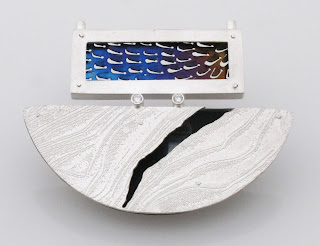Left to right: Voyage, 1986-1990; Wood Engraving, 25.4 x 21.2cm. Ship, 1979; Collage, 41.8 x 60.7cm. Deluge A, 1986-1990; Wood Engraving, 25.4 x 20.4cm.
Karasawa Hitoshi is a Japanese printmaker who provides much inspiration within my practice. Although our aesthetic practices could be considered antipodal, his prints infer analagous conceptual interests such as phenomenology, transience, and intimating the infinite. Hitoshi is also a great example of how Gaston Bachelard's phenomenological discussions can be applied to visual artworks rather than just written texts. However, the most intriguing aspect of Karasawa's work is the similarity he shares with Bachelard in his concern for the 'literary image'...
Although having worked in many mediums, Karasawa is predominantly a woodblock artist, and began his career in the early 70s. He is fundamentally inspired by the challenge to create literary images. However, in the Japanese language the word ‘literary’ is a rather derogatory term, implying that a work is restricted by words and unable to depict a free image (Toshio 2006, p.216). Fuelled by this challenge, Karasawa has used literature and language as inspiration to create his mythological worlds. However the success of his images is not in their ability to be controlled by words, but rather what is manifested through the stimulation of language to generate the image. In doing so Karasawa’s worlds are also linked by certain aesthetic commonalities, as Yamanashi Toshio describes:
"There is a pitch-black darkness leading to infinity, which is like cosmic space, and a faint twinkle of the stars are scattered there. From time to time, a star becomes a meteor and seems as if it might fall. Some lonely people float in the infinite dark and others are given human form to reside in a mythological world (Toshio 2006, p.217)".
Thus, Karasawa’s works are a source of phenomenological inspiration, for they allude to otherness, infinity, and transience, especially through the suggestion of silence stimulated through his use of cosmic space. As Gaston Bachelard argues:
"There is nothing like silence to suggest a sense of unlimited space. Sounds lend colour to space, and confer a sort of sound body upon it. But absence of sound leaves it quite pure and, in the silence, we are seized with the sensation of something vast and deep and boundless (Bachelard 1994, p.43)".
In this context, transience is further evoked as his characters seem to only exist within this particular moment within Karasawa’s narrative. Most importantly, his work is an example of how the infinite can exist within the intimate.
Reference List:
Bachelard, G 1994, The Poetics of Space, 1994 edn, Beacon Press, Boston.
Toshio Y, Reiko K, Tsutomu M, Hitoshi K 2006, Karasawa Hitoshi : A Retrospective 1971-2006, Museum of Modern Art, Kamakura & Hayama, Kamakura.





























